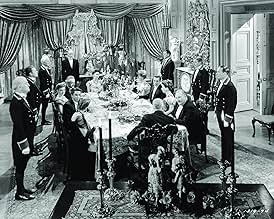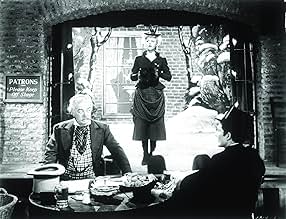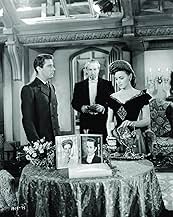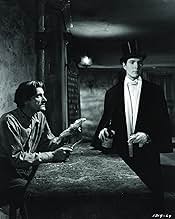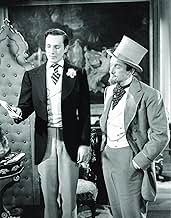NOTE IMDb
7,5/10
15 k
MA NOTE
Un jeune homme corrompu parvient curieusement à garder sa beauté juvénile, mais un tableau spécial révèle progressivement sa laideur intérieure.Un jeune homme corrompu parvient curieusement à garder sa beauté juvénile, mais un tableau spécial révèle progressivement sa laideur intérieure.Un jeune homme corrompu parvient curieusement à garder sa beauté juvénile, mais un tableau spécial révèle progressivement sa laideur intérieure.
- Réalisation
- Scénario
- Casting principal
- Récompensé par 1 Oscar
- 3 victoires et 4 nominations au total
Renee Carson
- Young French Woman
- (as Renie Carson)
Lilian Bond
- Kate
- (as Lillian Bond)
Devi Dja
- Lead Dancer
- (as Devi Dja and Her Balinese Dancers)
Avis à la une
It's hard to say what it is about "The Picture of Dorian Gray" that I enjoyed so much, but I did like it. Hurd Hatfield at first seems miscast and ineffective as the titular character, but somewhere around the one hour mark, his one and only expression begins to grow on you until you feel just as unnerved by his presence as those who come in contact with him in the story. George Sanders--from what I've seen--played one character his enter career but played it so well, and his performance in this film is no exception. Angela Lansbury is surprisingly sympathetic as the sad and timid singer. The only one in the cast who really doesn't work is Donna Reed. Her character feels tacked on, and she isn't allowed to do much but look faithful and beautiful.
The film is shot wonderfully, and Harry Stradling's cinematography gives the East End scenes a dark, atmospheric counter balance to the rather plain and flat interiors of Dorian's home. The swinging lamp was a nice touch and reminded me of "Psycho"'s finale.
I suppose my only criticism is toward the end, the story introduced one or two characters without giving them proper context or background (I'm thinking of the Allen Campbell character). I'm assuming Dorian "convinces" him to take part in his plans because of some sort past homosexual tryst, but it seemed unfair to bring him in they way he was, have him serve the role he does, and then disappear so quickly without explanation. And speaking of suggested themes: Is it just me, or could you make an argument that Dorian is Jack the Ripper? Maybe it's actually pretty obvious or maybe I'm just interpreting too much into the story, but that's what I got out of it.
P.S. I had the opportunity to see the actual painting from the film during an Ivan Albright exhibit at the Metropolitan Museum of Art in 1997. It's even more gruesome in person.
The film is shot wonderfully, and Harry Stradling's cinematography gives the East End scenes a dark, atmospheric counter balance to the rather plain and flat interiors of Dorian's home. The swinging lamp was a nice touch and reminded me of "Psycho"'s finale.
I suppose my only criticism is toward the end, the story introduced one or two characters without giving them proper context or background (I'm thinking of the Allen Campbell character). I'm assuming Dorian "convinces" him to take part in his plans because of some sort past homosexual tryst, but it seemed unfair to bring him in they way he was, have him serve the role he does, and then disappear so quickly without explanation. And speaking of suggested themes: Is it just me, or could you make an argument that Dorian is Jack the Ripper? Maybe it's actually pretty obvious or maybe I'm just interpreting too much into the story, but that's what I got out of it.
P.S. I had the opportunity to see the actual painting from the film during an Ivan Albright exhibit at the Metropolitan Museum of Art in 1997. It's even more gruesome in person.
The key word for this movie is elegance. The cast move through sumptuous sets with the males dressed in immaculately tailored dress suits and the women exquisitely gowned. It seems that all the aristocrats lived in homes the size of Buckingham palace with high ceilinged rooms and magnificent staircases. They exchange Oscar Wilde epigrams in the cultured tones of the British upper classes.
Some great performances. Hurd Hatfield, an extremely handsome actor with a limited range ,gives the best one of his career as does George Sanders as the cynical Lord Henry Wotton, and a young Angela Lansbury is very moving (especially when she sings "The Little Yellow Bird").
One (very small) criticism. The color shots of the Dorian Gray portrait showing his degradation don't match the high standards of the rest of the design, they look more like pages from a horror comic. I think the producer's, with their obviously high budget, could have used a more imaginative artist.
As I say a small criticism. This a great film of psychological horror.
Some great performances. Hurd Hatfield, an extremely handsome actor with a limited range ,gives the best one of his career as does George Sanders as the cynical Lord Henry Wotton, and a young Angela Lansbury is very moving (especially when she sings "The Little Yellow Bird").
One (very small) criticism. The color shots of the Dorian Gray portrait showing his degradation don't match the high standards of the rest of the design, they look more like pages from a horror comic. I think the producer's, with their obviously high budget, could have used a more imaginative artist.
As I say a small criticism. This a great film of psychological horror.
Elegant, atmospheric and measured. I suppose anyone brought up on fin de siecle Hollywood would interpret that as `slow and boring'. But this was Hollywood tackling an intellectual piece with, well, intellect. I must confess that the thought of a 1945 Hollywood attempt at Oscar Wilde did not appeal. Memories of one or two previous efforts at English literary classics set alarm bells ringing. But this was in a class of its own. Beautifully photographed in black and white, apart from a couple shots of the painting itself, the aesthetics shimmer.
I wasn't that convinced about some of the London scenes, especially the low-life portrayal of the East End. The opium den and the `Two Turtles', where Gray first meets Sibyl Vane, look rather too genteel. Compare this view of such places with those created by David Lean, just a couple of years later, in `Oliver Twist'. And this, in a sense, detracts from the depths to which Gray descends in order to be forever youthful and live life with scant regard for others. And in many years of watching BBC Victorian costume dramas I don't recall seeing such outfits on the backs of London's society ladies! However some of the other detail is first class. In particular Sir Thomas's decision to remain at table (`never could resist Aunt Agatha's quails') in spite of Lord Henry's outrageous comments rings true through to today. As the script had it `think like a Liberal, eat like a Tory'.
The acting is excellent with Hurd Hatfield's portrayal quite remarkable in that he wears the same expression virtually throughout, in order, no doubt, to conceal his true emotions. George Sanders, as Lord Henry, steals every scene he's in thanks to a rapid delivery of Wilde's witticisms that would have Groucho Marx and Woody Allen in awe. Angela Lansbury is, perhaps, a little too demure for a theatrical singer from the East End but, no doubt, this was a result of director's orders.
Essential viewing for anyone interested in the history of film.
I wasn't that convinced about some of the London scenes, especially the low-life portrayal of the East End. The opium den and the `Two Turtles', where Gray first meets Sibyl Vane, look rather too genteel. Compare this view of such places with those created by David Lean, just a couple of years later, in `Oliver Twist'. And this, in a sense, detracts from the depths to which Gray descends in order to be forever youthful and live life with scant regard for others. And in many years of watching BBC Victorian costume dramas I don't recall seeing such outfits on the backs of London's society ladies! However some of the other detail is first class. In particular Sir Thomas's decision to remain at table (`never could resist Aunt Agatha's quails') in spite of Lord Henry's outrageous comments rings true through to today. As the script had it `think like a Liberal, eat like a Tory'.
The acting is excellent with Hurd Hatfield's portrayal quite remarkable in that he wears the same expression virtually throughout, in order, no doubt, to conceal his true emotions. George Sanders, as Lord Henry, steals every scene he's in thanks to a rapid delivery of Wilde's witticisms that would have Groucho Marx and Woody Allen in awe. Angela Lansbury is, perhaps, a little too demure for a theatrical singer from the East End but, no doubt, this was a result of director's orders.
Essential viewing for anyone interested in the history of film.
This film adaptation of Wilde's story is certainly one of the great atmospheric black and white films of the 40's. Reminiscent of Greg Toland's ground breaking deep focus cinematography in "Citizen Kane",the shades of black, greys and whites are sharp and clearly deliniated to produce an unforgettable, somewhat eerie look to the film. There are a couple of short Technicolor shots that will make you jump. Cinematography is the star here but let's talk about Hurd Hatfield. I have seen this film on numerous occasions and have yet to figure out whether Hatfield is a great actor or just a woodenly inanimate object. Whichever is the case, this is the role of a lifetime.....it calls for an unfeeling, blank-faced characterization which is exactly as Hatfield played it. His smooth unlined visage hides many things and his apparent lack of emoting is right on target. Does that mean that he just couldn't act and fell into a role that suited his style or does it mean that he rose to the task and his interpretation was the sign of a great actor, living the part. I don't know....all I do know is that he pulls it off with great panache! He was playing against one of the great scene stealers of all times, George Sanders, who spouts Wilde epigrams with his own inimitable class and Hatfield holds his own. The other players are adequate but I don't know what all the excitement is about Angela Lansbury's acting....she was much better in "Gaslight". All in all, this is a movie that I would recommend but beware....it moves slowly, very slowly. Once you see it maybe you can answer the question about Hurd Hatfield's acting.....or maybe not!!!
This wonderfully atmospheric retelling of Oscar Wilde's chilling novel is one of the best horror films ever made. It outdoes DRACULA and FRANKENSTEIN because it is about a man -- not a monster. Yet the monster IS the man -- and hides within all of us. The story works even more effectively than the similar plot in Robert Louis Stevenson's STRANGE CASE OF DR. JEKYLL AND MR HYDE because here we have the dual sides of a man portrayed not as two separate characters but as two reflecting images -- like two mirrors facing each other, sending the images out to infinity. The painting itself is one of the most horrifing images ever created in films -- a surreal reflection of what each of us can become if we lose our humanity and replace it with careless egotism.
Le saviez-vous
- AnecdotesIvan Le Lorraine Albright's famous painting of the decayed Dorian Gray, which took approximately one year to complete, is now owned by the Art Institute of Chicago, where it has been on display for many years. Albright's twin brother Malvin, better known as a sculptor, was also commissioned to create a painting of the young Dorian for this movie, although his work went unused. The March 27, 1944, issue of Life Magazine included a story and photos of the brothers working on their paintings for this movie. Henrique Medina created the initial portrait of young Dorian that sets the story in motion.
- GaffesAt approximately 34:35 into the film, the time on the clock in the room suddenly changes from just after 2 o'clock to 3 o'clock. Then at approximately 37:00 it moves back to 2:05 and then to 2:09 as Dorian continues to play the piano.
- Citations
Lord Henry Wotton: "If I could get back my youth, I'd do anything in the world except get up early, take exercise or be respectable."
- Versions alternativesSome prints are slightly edited, omitting Dorian's prayer and Lord Henry's line, "Heaven forgive me" in the final scene.
- ConnexionsFeatured in The Cinematographer (1951)
- Bandes originalesGood-Bye, Little Yellow Bird
(uncredited)
Lyrics and Music by C.W. Murphy and William Hargreaves
Performed by Angela Lansbury
Meilleurs choix
Connectez-vous pour évaluer et suivre la liste de favoris afin de recevoir des recommandations personnalisées
Détails
- Date de sortie
- Pays d’origine
- Site officiel
- Langue
- Aussi connu sous le nom de
- El retrato de Dorian Gray
- Lieux de tournage
- Société de production
- Voir plus de crédits d'entreprise sur IMDbPro
Box-office
- Budget
- 3 500 000 $US (estimé)
- Durée
- 1h 50min(110 min)
- Couleur
- Rapport de forme
- 1.37 : 1
Contribuer à cette page
Suggérer une modification ou ajouter du contenu manquant


